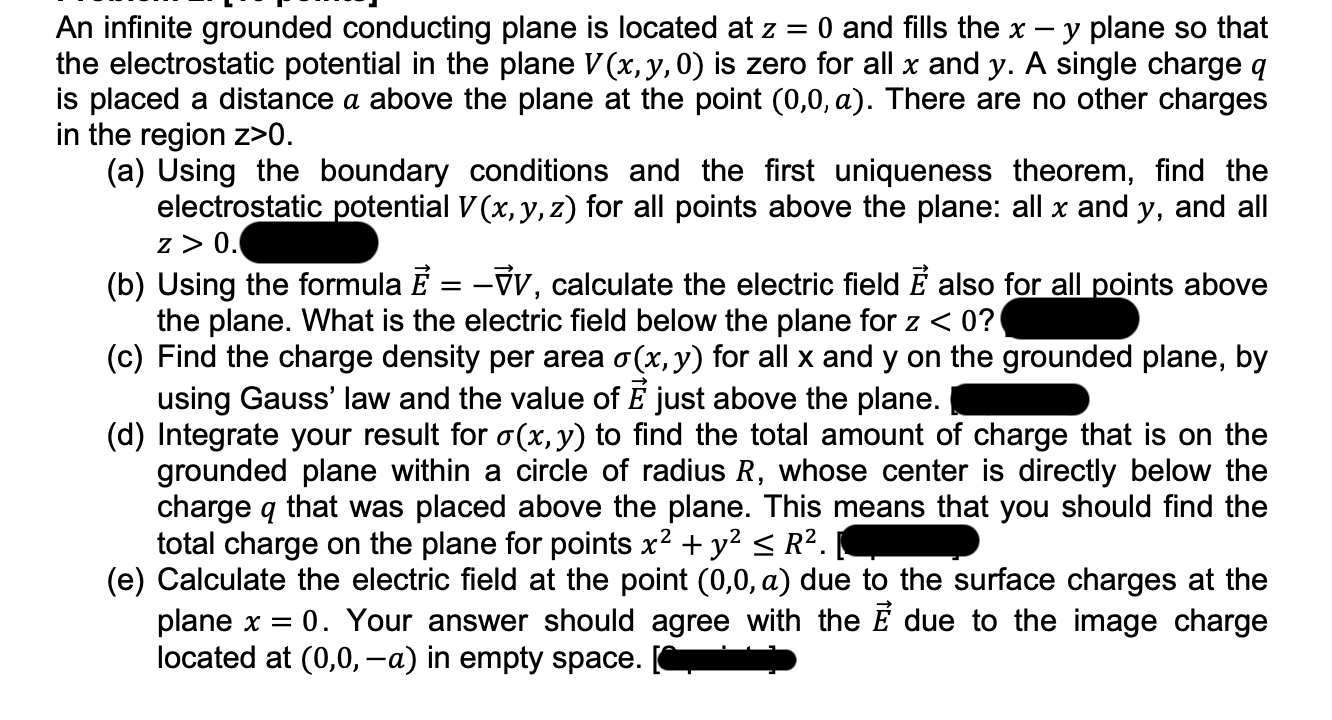An infinite grounded conducting plane is located at z = 0 and fills the x – y plane so that the electrostatic potential in the plane V (x, y, 0) is zero for all x and y. A single charge q is placed a distance a above the plane at the point (0,0, a). There are no other charges in the region z>0. (a) Using the boundary conditions and the first uniqueness theorem, find the electrostatic potential V (x, y, z) for all points above the plane: all x and y, and all z > 0. (b) Using the formula E = -V, calculate the electric field É also for all points above the plane. What is the electric field below the plane for z < 0? (c) Find the charge density per area o(x, y) for all x and y on the grounded plane, by using Gauss' law and the value of E just above the plane. (d) Integrate your result for o(x, y) to find the total amount of charge that is on the grounded plane wi charge q that was placed above the plane. This means that you should find the a circle of radius R, whose center is directly below the
An infinite grounded conducting plane is located at z = 0 and fills the x – y plane so that the electrostatic potential in the plane V (x, y, 0) is zero for all x and y. A single charge q is placed a distance a above the plane at the point (0,0, a). There are no other charges in the region z>0. (a) Using the boundary conditions and the first uniqueness theorem, find the electrostatic potential V (x, y, z) for all points above the plane: all x and y, and all z > 0. (b) Using the formula E = -V, calculate the electric field É also for all points above the plane. What is the electric field below the plane for z < 0? (c) Find the charge density per area o(x, y) for all x and y on the grounded plane, by using Gauss' law and the value of E just above the plane. (d) Integrate your result for o(x, y) to find the total amount of charge that is on the grounded plane wi charge q that was placed above the plane. This means that you should find the a circle of radius R, whose center is directly below the
Related questions
Question

Transcribed Image Text:An infinite grounded conducting plane is located at z = 0 and fills the x – y plane so that
the electrostatic potential in the plane V (x, y, 0) is zero for all x and y. A single charge q
is placed a distance a above the plane at the point (0,0, a). There are no other charges
in the region z>0.
(a) Using the boundary conditions and the first uniqueness theorem, find the
electrostatic potential V (x, y, z) for all points above the plane: all x and y, and all
z > 0.
(b) Using the formula E = -V, calculate the electric field É also for all points above
the plane. What is the electric field below the plane for z < 0?
(c) Find the charge density per area o(x, y) for all x and y on the grounded plane, by
using Gauss' law and the value of E just above the plane.
(d) Integrate your result for o(x, y) to find the total amount of charge that is on the
grounded plane wi
charge q that was placed above the plane. This means that you should find the
a circle of radius R, whose center is directly below the
Expert Solution
This question has been solved!
Explore an expertly crafted, step-by-step solution for a thorough understanding of key concepts.
This is a popular solution!
Trending now
This is a popular solution!
Step by step
Solved in 4 steps with 1 images
